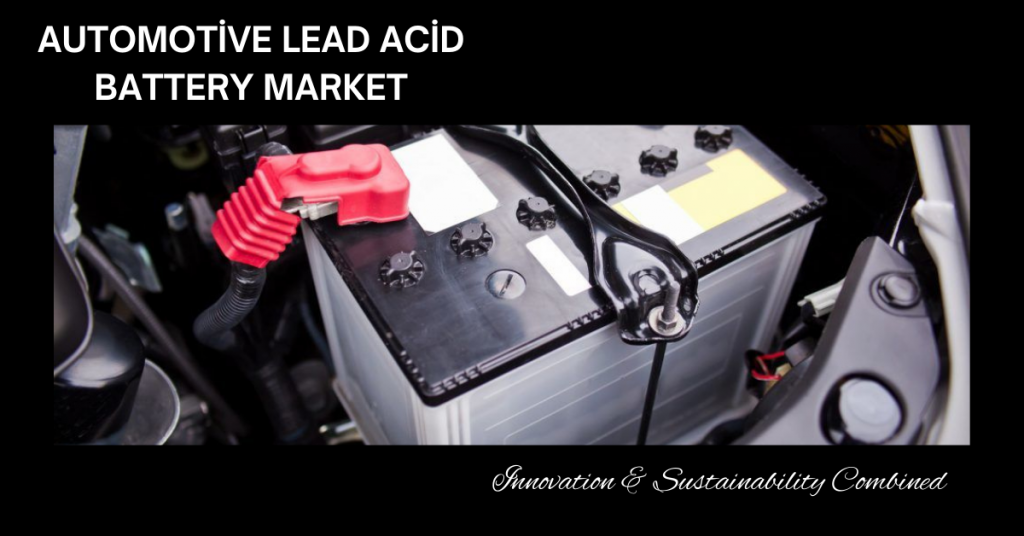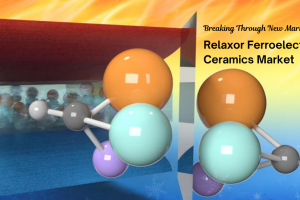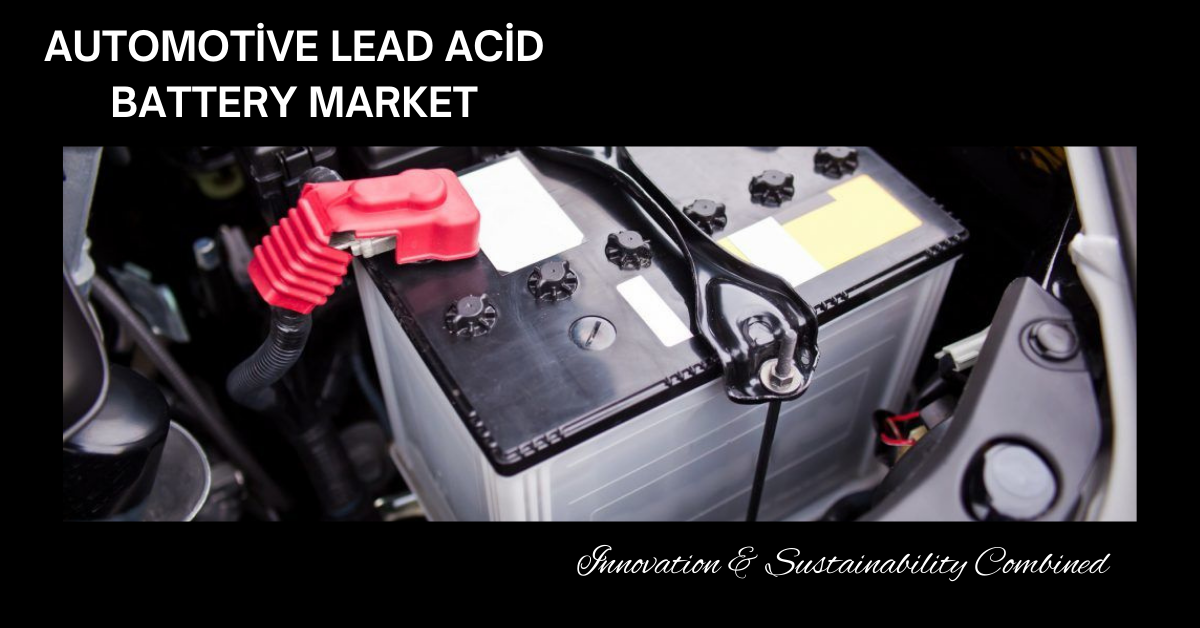
Market Overview
The Automotive Lead Acid Battery Market size is projected to grow from USD 21,181.34 million in 2023 to USD 43,052.54 million by 2032, at a compound annual growth rate (CAGR) of 8.2% during the forecast period. This significant growth trajectory underscores the enduring relevance of lead acid batteries, particularly in automotive applications where they continue to power various vehicle types globally.
In the evolving global automotive landscape, lead acid batteries remain a cornerstone technology. Despite the rise of alternative energy storage systems, the dependability, affordability, and robustness of lead acid batteries keep them vital for internal combustion engine (ICE) vehicles, hybrid vehicles, and even some electric vehicle systems as auxiliary power sources. Their recyclability and mature infrastructure further bolster their relevance, especially in markets with established automotive manufacturing bases.
Furthermore, the demand for automotive lead acid batteries is strongly supported by the aftermarket sector, with replacement cycles driving consistent sales. Emerging economies, rapid urbanization, and expansion of vehicle fleets also amplify the market’s potential. As vehicle electrification trends intersect with traditional automotive needs, lead acid batteries are expected to witness technological enhancements, including improved durability and performance. The market remains essential for various stakeholders, from OEMs to aftermarket players, ensuring its strategic importance in the broader automotive battery ecosystem.
Download .Sample Report: https://www.credenceresearch.com/report/automotive-lead-acid-battery-market
Market Drivers
Increased Vehicle Production Driving Demand
A key driver fueling the automotive lead acid battery market is the sustained growth in vehicle production across both developed and emerging economies. With increasing urbanization and consumer purchasing power, the global demand for passenger cars, commercial vehicles, and light trucks is on the rise. Lead acid batteries, being cost-effective and reliable, continue to dominate as the preferred choice for starter, lighting, and ignition (SLI) applications in ICE vehicles.
Growth in Aftermarket Sales Enhancing Market Revenues
The growing automotive aftermarket sector significantly contributes to the lead acid battery market. Due to battery degradation over time, regular replacements are necessary, providing steady revenue streams for battery manufacturers and distributors. Particularly in countries with aging vehicle fleets, such as those in Europe and North America, aftermarket sales play a crucial role in sustaining the demand for lead acid batteries.
Technological Enhancements Improving Product Performance
Advancements in battery technology have led to the development of enhanced flooded batteries (EFB) and absorbent glass mat (AGM) batteries. These variants offer improved charge acceptance, longer cycle life, and better performance in start-stop systems. This technological progression is expanding the application of lead acid batteries in modern vehicles, driving their adoption even in markets increasingly inclined toward fuel efficiency and environmental consciousness.
Recyclability Promoting Sustainability Goals
The high recyclability of lead acid batteries acts as a significant market driver, aligning with global sustainability initiatives. Lead acid batteries boast over 95% recycling efficiency, contributing to circular economy models. This eco-friendly attribute helps manufacturers meet regulatory compliance, supports sustainable manufacturing practices, and positions lead acid batteries as an environmentally responsible choice.
Market Challenges
Competition from Lithium-ion Batteries
The rising popularity of lithium-ion batteries poses a critical challenge to the automotive lead acid battery market. With better energy density and lightweight characteristics, lithium-ion technology is increasingly preferred in electric vehicles, hybrid cars, and even in some advanced SLI applications. This shift impacts lead acid battery demand in technologically progressive markets.
Stringent Environmental Regulations
Environmental concerns over lead usage and disposal create regulatory hurdles for manufacturers. Governments worldwide are implementing strict environmental policies and imposing taxes or bans on lead-related products, which might affect market expansion, particularly in regions with heightened ecological awareness.
Market Saturation in Developed Economies
In mature markets such as Europe and North America, the automotive lead acid battery market faces saturation. With high vehicle ownership rates and an aging vehicle population, the market’s growth potential is relatively stagnant, restricting new customer acquisition opportunities.
Technological Obsolescence Threats
As automotive technologies evolve, particularly with the emergence of advanced start-stop systems and micro-hybrid vehicles, the risk of obsolescence looms over traditional lead acid batteries. Manufacturers need to constantly innovate to remain relevant in a competitive and rapidly changing market landscape.
Market Opportunity
Emerging Markets Expansion Potential
Emerging economies in Asia Pacific, Latin America, and Africa present untapped opportunities for lead acid battery manufacturers. Rising disposable incomes, increasing vehicle penetration, and infrastructural growth fuel automotive sales, thus enhancing demand for lead acid batteries in these regions.
Growth in Electric Two- and Three-Wheeler Segments
Electric two- and three-wheelers, particularly in Asia, continue to utilize lead acid batteries due to cost considerations. This growing segment offers a lucrative market for affordable energy storage solutions, providing manufacturers with avenues to diversify their product offerings.
Technological Upgrades in Lead Acid Batteries
Innovations such as carbon additives, smart battery systems, and maintenance-free designs are extending the lifecycle and efficiency of lead acid batteries. These enhancements open new applications in micro-hybrids and renewable energy storage support, broadening the market scope.
Fleet Electrification in Commercial Vehicles
Fleet operators are embracing electric and hybrid commercial vehicles. Lead acid batteries remain essential for auxiliary functions and energy storage support. With increasing fleet electrification, opportunities arise for lead acid battery manufacturers to cater to specialized vehicle segments, including buses, delivery trucks, and logistics vehicles.
Market Segmentation
By Battery Type:
- Flooded
- Enhanced Flooded
- AGM
By Technology:
- ICE
- Hybrid
- Electric
By Vehicle Type:
- Passenger Car
- LCV
By Sales Channel:
- OEM
- Aftermarket
Based on Region North America
- U.S.
- Canada
- Mexico
Europe
- UK
- France
- Germany
- Italy
- Spain
- Russia
- Belgium
- Netherlands
- Austria
- Sweden
- Poland
- Denmark
- Switzerland
- Rest of Europe
Asia Pacific
- China
- Japan
- South Korea
- India
- Australia
- Thailand
- Indonesia
- Vietnam
- Malaysia
- Philippines
- Taiwan
- Rest of Asia Pacific
Latin America
- Brazil
- Argentina
- Peru
- Chile
- Colombia
- Rest of Latin America
Middle East & Africa
- GCC Countries
- South Africa
- Rest of the Middle East and Africa
Regional Analysis
North America
North America holds a significant share in the automotive lead acid battery market, driven by the large vehicle fleet and a robust aftermarket sector. The United States dominates the region, with consistent battery replacement demand and OEM partnerships. Moreover, fleet electrification trends and sustainability initiatives foster the need for efficient lead acid battery solutions, particularly in logistics and public transport sectors.
Europe
Europe represents a matured market with stringent environmental regulations influencing the demand for eco-friendly and recyclable lead acid batteries. Germany, France, and the UK are leading countries driving technology upgrades, especially in enhanced flooded and AGM battery types. The emphasis on sustainability and circular economy models further promotes lead acid battery recycling across the region.
Asia Pacific
Asia Pacific emerges as the fastest-growing region, with China, India, and Japan being major contributors. Rising automotive production, expanding vehicle ownership, and increasing demand for electric two- and three-wheelers underpin market growth. Government policies supporting electric mobility, coupled with the affordability of lead acid batteries, create lucrative opportunities for manufacturers.
Latin America
Latin America shows steady demand for automotive lead acid batteries, driven by vehicle replacement rates and aftermarket sales. Brazil and Mexico remain dominant, while Argentina and Chile are witnessing growth due to economic recovery and infrastructure expansion. The region offers prospects for cost-effective lead acid batteries in entry-level and commercial vehicles.
Middle East & Africa
The Middle East and Africa demonstrate growing demand fueled by rising vehicle ownership in Gulf Cooperation Council (GCC) countries and South Africa. Market growth is supported by infrastructure developments, logistics expansion, and a growing preference for durable and affordable battery solutions suitable for harsh climatic conditions.
Top Companies
- Clarios
- Exide Industries Limited
- EnerSys
- GS Yuasa Corporation
- East Penn Manufacturing Company, Inc.
- Amara Raja Batteries Ltd.
- Leoch International Technology Limited
- Panasonic Corporation
- C&D Technologies, Inc.
- Robert Bosch GmbH
Future Outlook
- Rising adoption of start-stop systems will fuel AGM and EFB lead acid battery demand.
- Emerging economies will remain key growth drivers in the automotive aftermarket segment.
- Recyclability advantages will position lead acid batteries as sustainable solutions in developed markets.
- Technological innovations will enhance lead acid battery lifespan and performance.
- Integration of lead acid batteries in electric two- and three-wheelers will continue to expand in Asia.
- Fleet electrification will open new market segments for auxiliary lead acid battery applications.
- Environmental regulations will push companies to invest in cleaner production methods.
- Strategic partnerships and acquisitions will shape the competitive landscape.
- Digitalization and IoT integration in battery monitoring will add value to lead acid battery offerings.
- R&D investments in hybrid energy storage solutions combining lead acid and lithium-ion will gain traction.
Download .Sample Report: https://www.credenceresearch.com/report/automotive-lead-acid-battery-market











